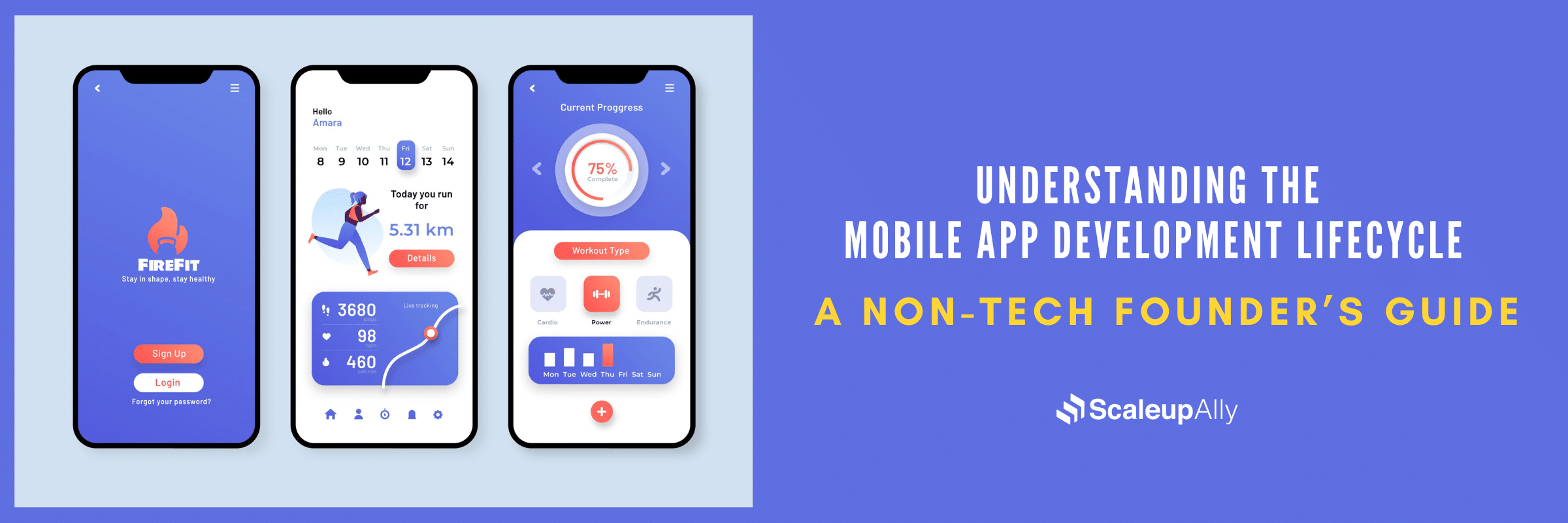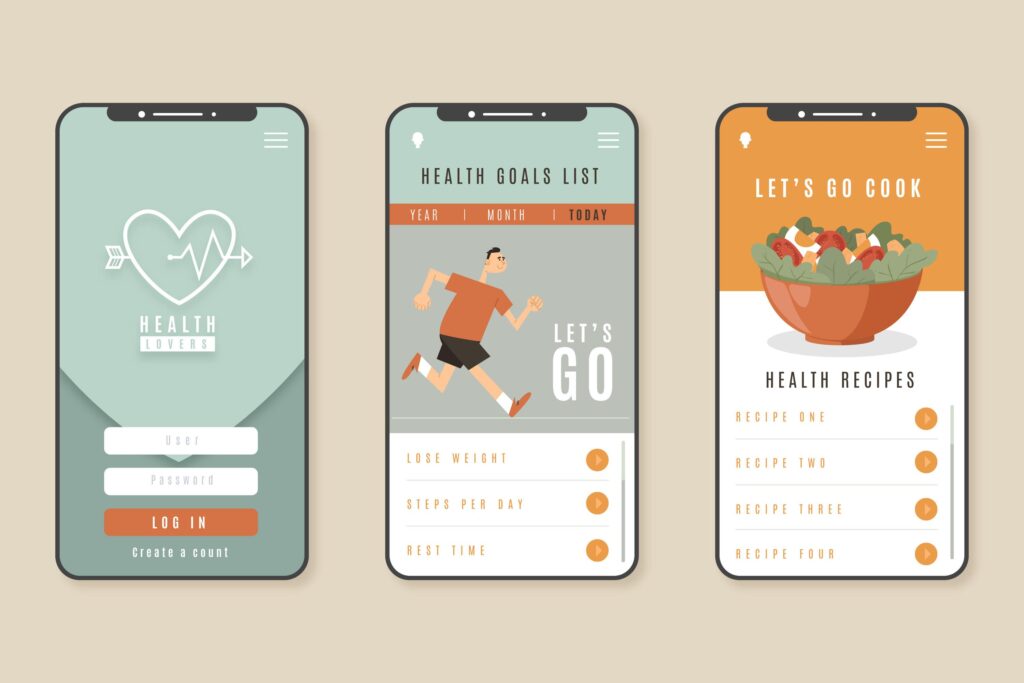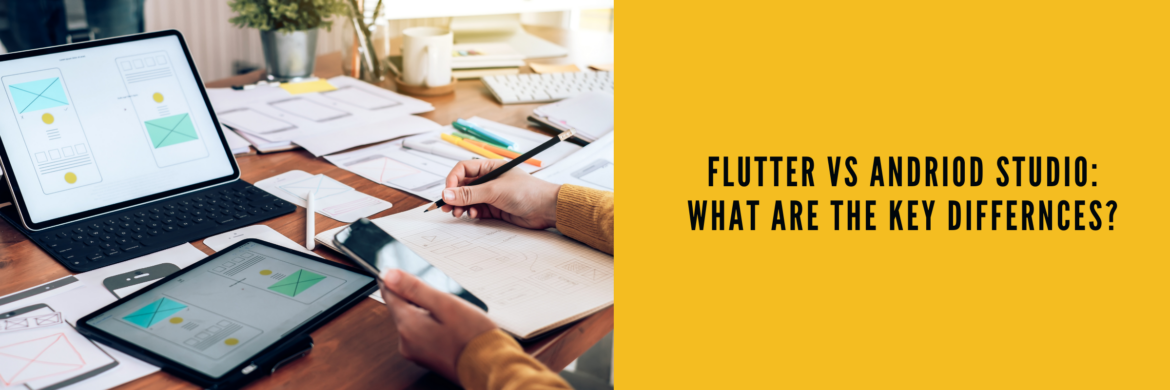
Understanding the Mobile App Development Lifecycle: A Non-Tech Founder’s Guide
Suprabhat Sen | September 7, 2023 , 21 min read
Table Of Content
Mobile app development has become a crucial aspect of business success in today’s digital world. With the increasing number of smartphone users and the growing popularity of mobile apps, businesses need to understand the mobile app development lifecycle to stay competitive in the market.
Mobile apps are expected to generate over $935 billion in revenue in 2023 and Mobile apps are projected to generate more than 613 billion U.S. dollars in revenues in 2025. In this comprehensive guide, we will explore the stages involved in mobile app development, from concept to launch, and provide valuable insights to help you navigate through the process successfully.
Understanding the Mobile App Development Life Cycle
Mobile applications have become an integral part of our lives, serving various purposes from entertainment to productivity. Have you ever wondered how these apps come into existence?
The answer lies in the mobile app development life cycle.
Let us break down this intricate process into six distinct stages and explore the world of mobile app development.
Stage 1: Idea Generation and Research
The inception of a remarkable mobile app begins with a spark of creativity, a eureka moment when developers envision an application that has the potential to revolutionize the mobile landscape. It’s not just about having an idea; it’s about idea generation and research, a process that lays the foundation for the entire mobile app development journey.
- Brainstorming Sessions: These are the incubators of innovation. Developers, designers, and stakeholders come together in brainstorming sessions to exchange ideas, explore possibilities, and challenge the status quo. The goal is to identify a concept that not only meets a need but also captures the user’s imagination.
- Defining Objectives: Every successful app has clear objectives. What is the problem it’s solving? What value will it bring to users’ lives? Defining these objectives helps shape the app’s purpose and direction.
- Setting Goals: To steer the development process, it’s crucial to set SMART (Specific, Measurable, Achievable, Relevant, Time-bound) goals. These goals act as a compass, guiding the team towards the desired destination.
- Market Research – Illuminating Insights: Market research takes center stage as it offers a deep dive into the app’s future environment. This involves studying the target audience, their preferences, behaviors, and pain points. It’s about understanding the competitive landscape, identifying what’s already out there, and how the app can stand out. Market research provides invaluable insights that help in shaping the app’s features and functionalities.
- Unique Selling Proposition (USP): In a sea of mobile apps, what makes your app unique and irresistible? This is where the Unique Selling Proposition comes into play. It’s not just a tagline but a statement that encapsulates what sets your app apart. It’s the ‘why’ that drives users to choose your app over others.
- Choosing the Development Platform: iOS, Android, or both? This decision is critical. It depends on factors like the target audience, budget, and timeline. Each platform has its own ecosystem and user base. Understanding these differences is pivotal to making the right choice.
This stage is not just about having a great idea; it’s about nurturing it, refining it, and giving it a solid foundation. Think of it as planting a seed that with the right care and attention, will grow into a magnificent tree. The Idea Generation and Research stage is where innovation takes place, setting the stage for the entire mobile app development cycle.
Stage 2: Wireframing and Design
Once the initial idea for the mobile app is well-defined, the development team transitions into the Wireframing and Design stage. This phase is akin to breathing life into a concept, shaping it into a tangible visual identity.
- The Role of Wireframes: Wireframes, in this context, act as the architectural blueprints of the mobile app. They provide a skeletal representation of the app’s structure and navigation. Think of it as a roadmap that guides developers and designers throughout the project. By creating wireframes, the team can visualize the layout and placement of various elements within the app. This process is critical as it helps in identifying potential challenges early on, ensuring a smoother development process.
- Prioritizing User Experience (UX): During the design phase, the user experience (UX) takes center stage. It’s not just about making the app look aesthetically pleasing; it’s about making it intuitive and user-friendly. User-friendliness is the hallmark of a successful app. The icons, buttons, and menus should be where users expect them to be, and the navigation should be a breeze.
- Moreover, the design should reflect the brand’s identity. This means the app’s look and feel should align seamlessly with the brand’s image, conveying a sense of continuity. Whether users access the app on a smartphone, tablet, or desktop, they should instantly recognize and connect with the brand. This consistency not only fosters trust but also makes for a more professional and engaging user experience.
- Consistency Across Platforms: In the diverse world of mobile devices, users expect the same experience, whether they are on iOS, Android, or any other platform. Therefore, the design should be consistent across all screens and platforms. It’s a challenging task, as different platforms have their unique design guidelines and requirements. Adhering to these standards while preserving the app’s core design principles is crucial to ensure that users on any platform have a seamless and familiar experience.
- Iteration and Collaboration: The Wireframing and Design stage is not a one-shot deal. It often involves multiple iterations and constant collaboration between designers, developers, and other stakeholders. Feedback from various team members is invaluable. It can uncover blind spots and improve the design’s quality. This iterative approach ensures that the final product is polished and user-focused.
In conclusion, the Wireframing and Design stage is where the foundations of the user experience are laid. It’s about creating a blueprint that guides the development process and ensures that the app is not only visually appealing but also highly functional and user-friendly.
By prioritizing user experience, aligning with the brand’s identity, and maintaining consistency across platforms, this phase sets the stage for the successful development of a mobile app that resonates with its users.
Stage 3: Development
The Development stage is the heart and soul of the mobile app development journey. It’s where the conceptual ideas and designs start to take shape as a functional and interactive mobile application. In this phase, developers roll up their sleeves, open their code editors, and embark on the exciting journey of bringing the app to life.
1. Choosing the Right Development Method
One of the initial decisions that developers need to make during this stage is choosing the most suitable development method. This decision can significantly impact the project’s outcome.
The two primary approaches are native development and cross-platform development, each with its set of advantages and considerations.
- Native Development: Native app development involves creating applications specifically tailored to a particular platform, such as iOS or Android. These apps are optimized for the operating system’s unique features and capabilities, resulting in a seamless user experience. Native development is a preferred choice when high performance and access to platform-specific features are essential. However, it may require more time and resources since separate codebases are needed for different platforms.
- Cross-Platform Development: Cross-platform development, on the other hand, allows developers to write code that can run on multiple platforms, reducing the need for separate codebases. Tools like React Native and Flutter have gained popularity in this space. Cross-platform development is an efficient choice when time and budget constraints come into play. It allows for faster development and maintenance of apps across various platforms. However, it may not offer the same level of optimization and access to platform-specific features as native development.
The choice between these two methods depends on several factors, including your project’s budget, timeline, and the target audience. It’s crucial to weigh the pros and cons and make an informed decision that aligns with your project’s goals.
2. Collaboration: Designers and Developers in Harmony
In the Development stage, seamless collaboration between designers and developers is vital. These two teams must work in perfect harmony to ensure that the app’s functionality aligns with its design specifications. Developers need to understand the design principles and user experience (UX) guidelines to bring the visual elements to life effectively.
This collaboration goes beyond just sharing ideas; it involves clear communication and mutual understanding of the project’s objectives. Frequent meetings and brainstorming sessions ensure that the app’s development stays on course and aligns with the initial design concepts.
This partnership helps resolve any discrepancies between design and functionality early in the development process, preventing potential setbacks in the later stages.
3. Coding Best Practices: Building a Strong Foundation
Developers follow coding best practices to build a solid foundation for the app. This includes writing clean, efficient, and maintainable code that will be easy to work with during the development journey. Best practices also involve following industry standards and guidelines to ensure the app’s security, scalability, and compatibility.
Another aspect of coding best practices is the use of version control systems like Git. This enables multiple developers to work on the project simultaneously while keeping track of changes, allowing for efficient collaboration and troubleshooting.
4. Ensuring Compatibility Across Devices and Operating Systems
As the app’s functionality takes shape, developers need to ensure that it’s compatible with a wide range of devices and operating systems. This is particularly crucial in the diverse world of mobile devices, where screen sizes, resolutions, and hardware capabilities can vary significantly.
A responsive design approach helps in creating an app that adapts seamlessly to different screen sizes and orientations. Thorough testing on various devices and operating systems is essential to identify and resolve compatibility issues.
The Development stage is the pivotal point where the mobile app’s concept evolves into a functional reality. Careful consideration of the development method, collaboration between designers and developers, adherence to coding best practices, and ensuring compatibility across devices are all essential aspects that contribute to the success of this phase. It’s where the app starts to come to life, setting the stage for the next critical step: Testing.
Stage 4: Testing
Testing is a pivotal phase within the mobile app development lifecycle, serving as the last line of defense before your app reaches the hands of users. The primary objective here is to ensure the app’s functionality, performance, and security are top-notch.
- Functional Testing: This is where the app’s features are scrutinized. Testers navigate through every nook and cranny, ensuring that all buttons, links, and functions perform as intended. They verify that your app’s registration process, search functionality, or in-app purchases work seamlessly, leaving no room for user frustration.
- Usability Testing: Usability goes hand in hand with user experience. Testers evaluate how user-friendly your app is. Is the navigation intuitive? Are the menus easy to understand? Usability testing reveals areas where your app’s design may need refinement, enhancing the overall user experience.
- Compatibility Testing: With the multitude of devices and operating systems available, ensuring your app works seamlessly on all of them is paramount. Compatibility testing verifies that your app looks and functions correctly across various devices, screen sizes, and operating systems. This is essential for delivering a consistent experience to all users.
- Security Testing: In an age of data breaches and cyber threats, security is a critical concern. Testers assess the app’s defenses against potential vulnerabilities. They look for weaknesses in data encryption, authentication processes, and potential points of entry for hackers. Security testing ensures your users’ data remains safe and your app maintains its integrity.
Any bugs or issues discovered during the testing phase should be addressed with swiftness. Prompt resolution of these issues is crucial to providing a seamless and frustration-free user experience.
User feedback is a valuable asset during this stage. Beta testing, where a limited number of users are given access to the app, helps you uncover any additional issues that may not have been apparent during internal testing. These beta testers provide real-world feedback, allowing you to fine-tune your app further before its public release.
In summary, the Testing stage is the gatekeeper of app quality. It ensures that the functionality, usability, compatibility, and security of your app meet the highest standards. It’s the last step before your app embarks on its journey into the hands of eager users, and it plays a pivotal role in shaping their overall experience.
Quality testing guarantees that your app will be well-received and that users will keep coming back for more. So, remember, the Testing stage is where your app transforms from a work in progress into a polished gem, ready to shine in the app stores.
Stage 5: Deployment
So, you’ve successfully navigated the turbulent waters of development and testing, and your app is now a polished gem. The next step in the Mobile App Development Lifecycle is Deployment, the moment when your creation is released into the wild. But before users can start downloading and enjoying your app, there are some crucial steps to follow.
- Tailoring to Different Platforms: First, let’s talk platforms. For iOS and Android apps, there are distinct processes that need to be followed. iOS apps need to be submitted to the Apple App Store, while Android apps find their home in the Google Play Store. Both stores have their unique requirements and guidelines, so it’s essential to understand and adhere to them.
- Crafting App Metadata: To make your app discoverable in the vast sea of mobile applications, you need to create compelling app metadata. This includes well-crafted descriptions, strategic keywords, and attention-grabbing screenshots. These elements serve as your app’s first impression, and a well-optimized presence can significantly boost your app’s visibility.
- Descriptions that Sell: Your app’s description is your elevator pitch to potential users. It needs to convey the app’s purpose, features, and benefits clearly and concisely. Make sure to highlight what sets your app apart from the competition. Using persuasive language can also go a long way in attracting users.
- Keywords for Discoverability: Keywords are the compass that guides users to your app. Research and choose your keywords wisely. Think about what terms your potential users might search for. Incorporate these keywords naturally into your description and metadata.
- Eye-Catching Screenshots: Visuals matter. Screenshots offer a glimpse into your app’s interface and functionality. Use them to showcase the most attractive and distinctive aspects of your app. A well-designed and visually appealing set of screenshots can entice users to explore further.
- Meeting Store Guidelines: Each app store has its own set of guidelines and policies that must be followed. These guidelines cover everything from the design of your app icon to the age-appropriateness of your content. Violating these guidelines can lead to your app’s rejection, so a thorough understanding of the rules is crucial.
- The Wait and the Release: After submitting your app, there’s a waiting period. The respective app stores will review your submission, checking for compliance with their guidelines. This review process can take some time, so patience is key.
Once your app is approved, it’s an exciting moment. It’s now available for users to download and install. This is when your hard work and dedication pay off as users start engaging with your creation. But remember, deployment is not the end of the road. It’s the beginning of a new chapter in your app’s journey.
The real challenge is making your app stand out in the crowded marketplace and ensuring that users have a positive experience.
So, get ready to embrace the world of mobile app deployment and share your creation with the world. It’s a thrilling step in the Mobile App Development Life Cycle, and it’s where your app begins to make its mark.
Stage 6: Post-Launch Maintenance and Updates (The Ongoing Journey)
The launch of a mobile app is not the finish line; rather, it marks the start of a new phase in its lifecycle. Post-launch maintenance and updates are integral to ensure that the app continues to meet user expectations, remains secure, and stays competitive in an ever-evolving digital landscape.
- Continuous Monitoring: Once the app is live, continuous monitoring becomes paramount. Developers and quality assurance teams need to keep a vigilant eye on how the app is performing in the real world. This monitoring involves not only tracking the app’s overall performance but also its behavior on different devices and operating systems. It’s crucial to spot any anomalies, like sudden crashes, performance hiccups, or security breaches. This vigilant oversight helps in addressing issues swiftly, minimizing user frustration, and maintaining a positive user experience.
- The Role of Regular Updates: The tech world moves at a rapid pace, with new devices, operating system updates, and user preferences constantly emerging. To stay relevant, mobile apps must adapt. Regular updates are the lifeblood of an app’s longevity. These updates serve several purposes:
-
- Bug Fixes: No matter how thorough the testing phase was, some bugs may only reveal themselves once the app is in the hands of thousands or millions of users. Post-launch updates are essential to address and eliminate these unexpected bugs. Swift response to bug reports and consistent bug-fixing demonstrates a commitment to user satisfaction.
- New Features: In response to user feedback and changing market demands, developers often introduce new features or enhance existing ones. These additions not only keep users engaged but also attract new ones. Listening to user suggestions and integrating them into app updates can foster a loyal and dedicated user base.
- Security: In an age of growing cybersecurity threats, the app’s security should be a top priority. Regular updates should address potential vulnerabilities and apply security patches as needed. Ensuring the safety of user data is non-negotiable.
- Performance Optimization: As the app accumulates data and users, its performance may start to lag. Regular updates include performance optimization measures to maintain a smooth and responsive user experience. This could involve optimizing code, reducing load times, or improving overall efficiency.
- User Feedback: User feedback is a goldmine of insights. Actively encouraging and collecting feedback from users is a strategy for constant improvement. Analyzing this feedback helps identify pain points, areas for enhancement, and features that are particularly well-received. This data-driven approach allows developers to make informed decisions about what changes and updates are most pressing, thus aligning app development with user expectations.
- Analytics: Analytics data also plays a crucial role in assessing app performance. Metrics such as user engagement, retention rates, and user journey analysis provide a comprehensive view of how users interact with the app. These insights can drive strategic updates, ultimately resulting in an app that’s more enjoyable and valuable to its users.
So, remember, it’s not just about launching the app; it’s about nurturing it, allowing it to flourish, and staying responsive to the ever-changing needs and expectations of its users. This is the essence of the Post-Launch Maintenance and Updates stage in the Android app development cycle.
Mobile App Development Platforms and Technologies
Choosing the right mobile app development platform and technology stack is crucial for the success of your app. Here are some popular platforms and technologies used in mobile app development:
1. Flutter
Flutter is an open-source mobile app development SDK developed by Google. It allows developers to create cross-platform apps with a single codebase. Flutter uses the Dart programming language and provides a rich set of UI components and libraries. It offers fast development and excellent performance, making it an ideal choice for building high-quality mobile apps.
2. React Native
React Native, developed by Facebook, is another popular framework for building cross-platform apps. It uses JavaScript and allows developers to build native-like apps for both iOS and Android platforms. React Native provides a wide range of pre-built components and allows for hot-reloading, enabling quick development and easy code sharing between platforms.
3. Native App Development (Java/Kotlin for Android, Swift/Objective-C for iOS)
Native app development involves writing separate codebases for each platform using the platform-specific programming languages. For Android apps, developers use Java or Kotlin, while iOS apps are developed using Swift or Objective-C. Native app development offers maximum performance and access to platform-specific features but requires more development time and resources.
4. Python
Python is a versatile programming language that can be used for mobile app development. It offers a wide range of frameworks and libraries, such as Kivy and BeeWare, that allow developers to create cross-platform apps. Python’s simplicity and readability make it an excellent choice for rapid app development.
5. Java
Java is the official programming language for Android app development. It provides a robust set of libraries and tools for building native Android apps. With Java, developers can create powerful and feature-rich apps that leverage the full potential of the Android platform.

Factors to Consider in Mobile App Development
Several factors should be considered to ensure the success of your mobile app. These factors include:
Target Audience
Understanding your target audience is essential for designing and developing an app that meets their needs and preferences. Conduct market research to identify your audience’s demographics, behaviors, and expectations. This will help you tailor your app’s features and user experience to their specific requirements.
User Experience
User experience (UX) plays a crucial role in the success of a mobile app. Design your app with a user-centric approach, focusing on intuitive navigation, visually appealing interfaces, and seamless interactions. Conduct user testing and gather feedback to refine and improve the app’s UX.
Platform Selection
Choose the right platform(s) for your app based on your target audience and business objectives. Consider factors such as market share, user demographics, and development resources. Developing for both iOS and Android platforms can maximize your app’s reach but requires additional development time and resources.
App Security
App security is of utmost importance to protect user data and maintain user trust. Implement robust security measures, such as data encryption, secure authentication, and secure data storage. Regularly update your app to address security vulnerabilities and stay ahead of potential threats.
Performance Optimization
Optimizing your app’s performance is crucial to provide a smooth and responsive user experience. Minimize app load times, reduce memory usage, and optimize code for faster execution. Conduct performance testing and identify areas for improvement to enhance your app’s performance.
Ensuring the Success of Your Mobile App
Launching a mobile app is just the beginning. To ensure its success, you need to adopt the following strategies:
App Store Optimization (ASO)
Optimize your app’s metadata, including the title, description, and keywords, to improve its visibility in the app stores. Focus on relevant keywords, compelling descriptions, and eye-catching screenshots to attract users and increase app downloads.
User Engagement and Retention
Implement features that encourage user engagement and retention, such as push notifications, in-app messaging, and personalized experiences. Regularly communicate with your users, gather feedback, and address their concerns to keep them engaged and satisfied.
App Analytics and Performance Monitoring
Track and analyze key metrics, such as app downloads, user engagement, and retention rates, using app analytics tools. Monitor your app’s performance, identify areas for improvement, and make data-driven decisions to enhance the app’s success.
Regular Updates and Bug Fixes
Release regular updates to address bugs, add new features, and improve the overall app experience. Promptly address user feedback and bug reports to ensure a seamless user experience and maintain user satisfaction.
Conclusion
The mobile app development life cycle is a complex process that requires careful planning, design, development, testing, and deployment. By following a systematic approach and considering key factors such as target audience, user experience, platform selection, app security, and performance optimization, businesses can create successful mobile apps that meet user needs and drive business growth.
Remember to choose the right mobile app development platform and technology stack based on your app’s requirements. Leverage tools and frameworks like Flutter, React Native, Python, Java, and Swift to streamline the development process and create high-quality mobile apps.
To ensure the long-term success of your mobile app, engage with your users, gather feedback, and continually update and improve your app based on user insights and market trends.
With a well-executed mobile app development strategy, businesses can leverage the power of mobile technology to revolutionize their operations and stay ahead in today’s competitive digital landscape.
FAQs
Q1: How long does the mobile app development life cycle typically take?
The duration varies depending on complexity, but it can range from a few months to over a year. Factors such as features, platforms, and team size play a significant role.
Q2: Do I need technical knowledge to manage the development process?
While technical knowledge can be beneficial, it’s not a prerequisite. Hiring experienced developers and project managers can bridge the gap for non-tech founders.
Q3: What is the most critical stage of the development life cycle?
All stages are important, but planning and market research are often considered the foundation of a successful app.
Related Blogs

Developing an App Like Airbnb in 2025: Costs, Key Considerations & Money-Saving Tips
Discover the cost to build an app like Airbnb, key factors, app types, and smart ways to optimize development expenses for better ROI.
Suprabhat Sen
Jun 29 ,
10 min read

Flutter vs Android Studio: What are the Key Differences?
Flutter vs Android Studio: Wondering which technology to choose to build your next app. Here is a detailed guide that will help you make a decision.
Suprabhat Sen
Jun 28 ,
14 min read

Software Development as a Service(SDaaS): The Complete Guide
Explore how SDaaS can streamline your development process, reduce costs, and boost your competitive edge. Learn how SDaaS can empower your business.
Suprabhat Sen
Jun 28 ,
16 min read








